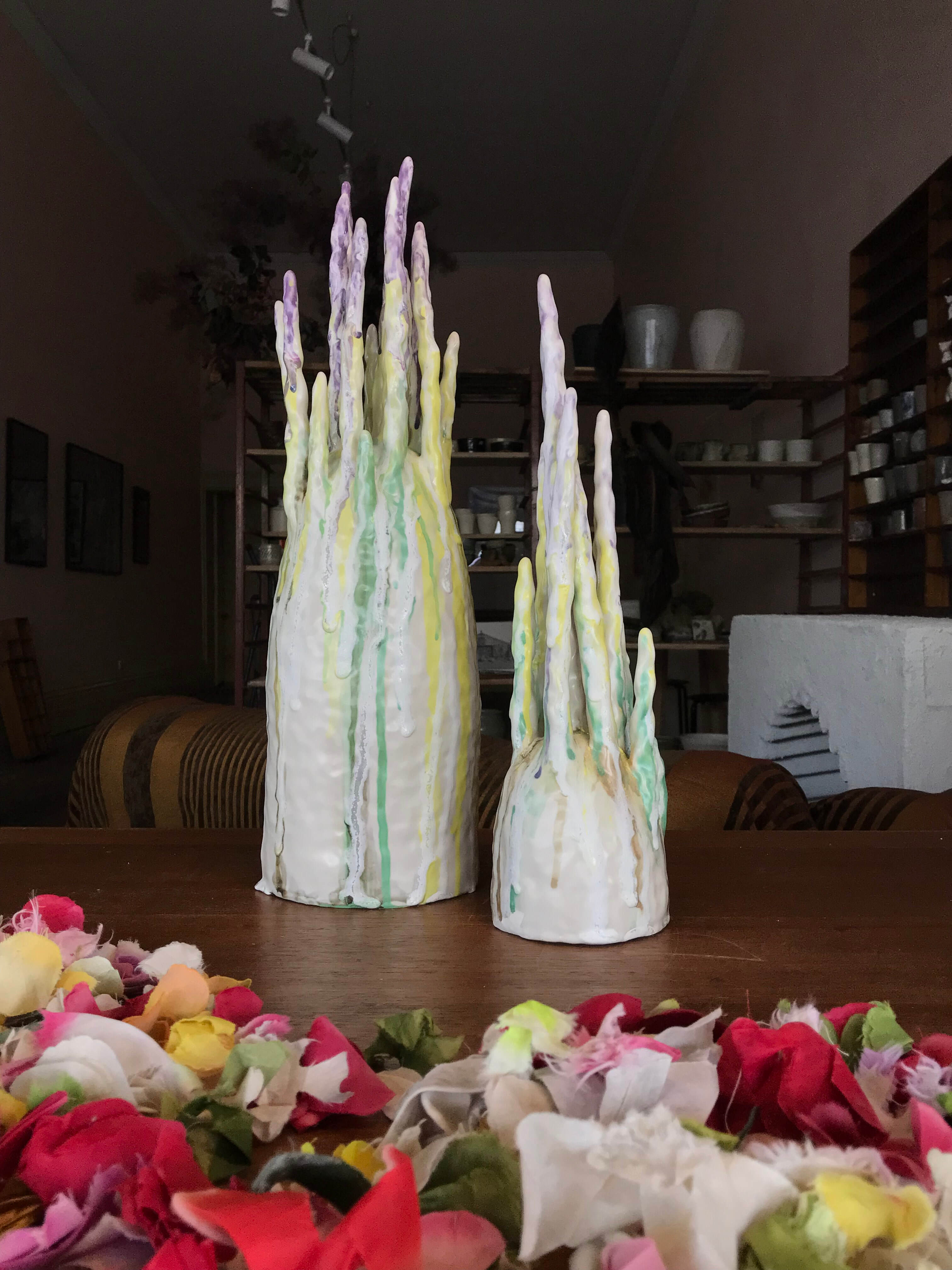Window Sessions (reflective) presents an ever-changing installation of contemporary ceramic and spacial experimentation.
Located at 54 Errol Street in North Melbourne’s local shopping strip, Group Session is a new gallery and community art space facilitated by the joint talents of Fluff Corp, Kate Jones, and Liz Errol and supported by the City of Melbourne's Creative Spaces.
Peruse the shopfront window 24/7, in the shade of Errol Street’s verandah during the first two weeks of 2023.
Window Session 3 - where yellow resides
This final window installation reflects on themes that demand the colour yellow to be used. Ceramic colour processes range from the very ancient terra sigillata of stained and refined slip. Faïence or majolica over terracotta clay and low-fired to allow the full brilliance of ceramic stains. Lastly, stoneware glazes with yellow stains hold their own in the vitrified surface.
Find yellow:
depicting the bountiful bloom of wattle, the intensity of golden wattle compared to its subtle but tenacious sister the black wattle
the watery organic essence of the smell of petrichor, the term given by the ancient Greek's to the smell of the earth's surface just a soft rain is falling after a hot day
the colour yellow, of soft morning sunlight as it seeps through a window, hinting at the coming heat
Window Session 2 - the potential of a series of compressive acts on clay
Compression is a ‘noun of action’ derived from Latin compressionem ‘a pressing together’ and comprimere ‘to squeeze’ an exquisitely accurate description of my hand/clay action.
Merrijig Tree
I stand beneath your canopy,
overwhelmed by your scale.
Your sinuous arts stretch and strain as if yawning;
I have intruded on the morning.
Should I call to announce my presence; call onto Country as Aboriginal respectfully do?
It seems the right thing to do.
I am enfolded as I lean against your trunk.
I press, you resist; kindly.
I leave, nothing has changed at this site.
I have changed.
I am peaceful.
I have both taken and received.
This is enough.
Field notes, Merrijig, 21 July 2019
Robyn Phelan
There is an important conceptual difference brought about by the compression of clay onto the tree surface.
I am no longer ‘looking at’ the landscape but ‘engaging with’ it.
The compressed clay components are used directly into the form that I am constructing, rather than my hand compressing clay to coax and conjure my experience (as seen in the pinch pot technique). My engagement with this place has shifted from a gaze to a touch and with this shift, a haptic intimate relationship that is full of creative potential.
Clay as my material of choice, is an active participant in this relationship and by association, an intimate correspondence with the site.
About touch - Robyn Phelan
Clay’s characteristics of plasticity, being responsive to the pressure of the hand, and importantly, when clay is a coil, they can be laid in repetitive sequence and motion to build a greater whole. This combination of a material that yields to compression, a body (my body) that works with tacit understanding and a process of flow and repeat is one that is familiar to me and to many creative practices
About clay - Robyn Phelan
Ceramic objects grow from a plastic mass of clay.
Impressions from fingertips and knuckles expand the clay at the same time and opening out and creating the form. This is an act of compression, the clay between my hands.
This action activates an tangible way of distilling an affective experiences into object, a clay artefact.
Potential of compression - Robyn Phelan
Window Session 1 - a reflection on trees & landscape
A tree is never just a tree.
It speaks of the history of the place where it has grown or been planted: the hills that were dynamited, the creeks that were concreted, the water that has been drained to give it a place to root. It speaks of the displacement of First Nations.
Of the endless lust of the governments (small and large) to control places and the way in which trees should or should not grow,
the ways in which humans should or should not live.
Sophie Cunningham, City of Trees: Essays on Life, Death and the Need for a Forest, 2019
The ancestors told me about all the plants and trees and how to use them.
They told me that the plants were pregnant with seeds, that the plants were our mothers and so I was only to use them for the Gondiwindi, not for selling,
just for living.
Remember that, wherever you go and touch the trees and plants, they are sacred.
Tara June Winch, The Yield, 2019
















